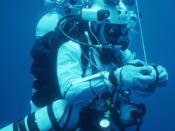Cerebrovascular disease, a "stroke" or "brain attack", occurs when the blood supply to a part of your brain is blocked or severely reduced, by a blood vessel breaking or a clot, and the brain tissue is deprived of oxygen and nutrients. Within a few minutes to a few hours, the brain cells begin to die. When brain cells die during a stroke, abilities or functions controlled by that part of the brain are lost. These include speech, movement, and memory among others. How a stroke patient is affected depends on where the stroke occurred in the brain and how much the brain is damaged. For example, someone who has a small stroke may experience only minor problems like weakness of an arm or leg. People who have larger strokes may be paralyzed on one side or lose heir ability to speak. Some people recover completely from strokes but more than two-thirds of survivors will have some type of life long disability (Mayo).
In the United States stroke is the third leading cause of death and a leading cause of adult disability (Mayo). Every year approximately 700,000 Americans experience a stroke and about 160,000 of these people die (Mayo). Presently fewer Americans die from strokes than 20 or 30 years ago. People controlling major risk factors such as smoking, high blood pressure, and high cholesterol are more likely the reason for the decline. 80% of strokes are preventable! (NAN)
There are two levels of a stroke: The Transient Ischemic Attack (TIA) which is a minor stroke or sometimes called a "mini stroke" and a Cerebral Vascular Attack (CVA) which is a major stroke and also has sub categories of different types of strokes. The duration of symptoms and the determination of brain injury is the main difference between the TIA and...

![May E. Miller - Trungeon [i.e., Trudgeon] stroke (LOC)](https://s.writework.com/uploads/7/76000/may-e-miller-trungeon-e-trudgeon-stroke-loc-thumb.jpg)
